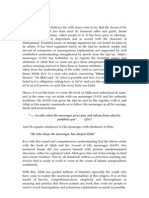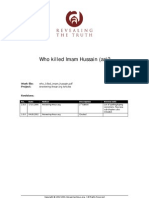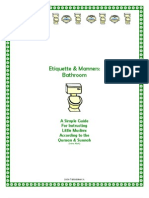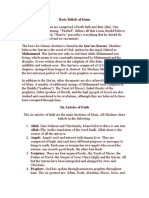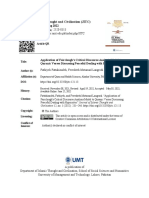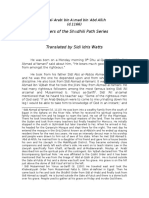Hazrat Uthman: Khs Islamiyat Notes Series 2019
Hazrat Uthman: Khs Islamiyat Notes Series 2019
Uploaded by
Anas AdilCopyright:
Available Formats
Hazrat Uthman: Khs Islamiyat Notes Series 2019
Hazrat Uthman: Khs Islamiyat Notes Series 2019
Uploaded by
Anas AdilOriginal Title
Copyright
Available Formats
Share this document
Did you find this document useful?
Is this content inappropriate?
Copyright:
Available Formats
Hazrat Uthman: Khs Islamiyat Notes Series 2019
Hazrat Uthman: Khs Islamiyat Notes Series 2019
Uploaded by
Anas AdilCopyright:
Available Formats
KHS* ISLAMIYAT NOTES SERIES 2019
HAZRAT UTHMAN Radi Allahu Anhu
Early Life:
He was born in 573 A.D. in a tribe of Quraysh named Banu Umayyad which was the second to Banu Hashim in
Political importance.
His father Affan was one of the rich Ranked businessmen of the Tribe.
He was an educated and generous person who never indulges himself in any indecent activity.
Acceptance:
He accepted Islam at the hands of Hazrat Abu Bakr (R.A.) and was named as Uthman.
He married the two daughters of Holy Prophet (SAWS), thus titled as “ Zun-Noorain (Possessor of two lights).
He set most of his wealth for the cause of development of Islam.
Services:
He undertook 2 migrations for the cause of Islam; one to Abyssinia and another to Medina.
He spent 20,000 Dirhams on digging the well on the desire of Prophet Muhammad (SAWS).
He further spent to purchase an adjoining piece of land for the extension of Masjid-e-Nabwi on the desire of Holy
Prophet (SAWS).
He freed a large number of Muslim slaves and helped the poor & needy people.
Uthman (R.A.) contributed 1,000 Dirhams & 300 camels for Tabuk expedition for the cause of Islam.
He participated in all battles fought during the lifetime of Holy Prophet (SAWS) except the Battle of Badr in which his
wife fell unwell.
He acted as a representative of the Muslims to convey the message of Prophet (SAWS) to Mecca at the event of
Hudaybiya.
He rendered the great service to Islam by standardizing the Copies’ script of Holy Qur’an.
Caliphate:
During his Caliphate (644 A.D. – 656 A.D.), the whole of North Africa was conquered including Libya, Tunisia, Algeria
and Morocco. His kingdom was stretched from Kabul to Morocco.
The Island of Cyprus was also captured during his Caliphate.
He confronted severe charges during his Caliphate on the following issues:
Appointment of Governors
Utilization of wealth from the public treasury
Burning of the copy of Quran
None supervision of the activities of Governors
He constructed new Mosques wherever required. He made arrangements to supply water to travelers by having wells
dug near the roads.
Martyrdom:
Hazrat Uthman (R.A.) was cruelly martyred by the Insurgents in 656 A.D. when he was reciting the Holy Qur’an in his
house.
MAIN EVENTS
Conquests in the East and the West.
Charges by the conflictors.
Opposition of the insurgents.
Compilation of the standardized Holy Qur’an.
Martyrdom of Hazrat Uthman (R.A.)
CHARACTER & PERSONALITY
A Chaste, modest and a gentle person with a refined character.
He ensured that his actions did not offend anyone.
He had simple manners and did not indulge in luxury, though the wealth of the entire state lay at his disposal.
He was known for his generosity and did not abstain from helping the needy and poor, from his earnings.
His life before becoming a caliph and his character:
• Hazrat Usman belonged to Banu Umayyah family of the Quraish.
• His father’s name was Affan.
• He was born in Makkah in the 6th year of the Elephant.
• His mother’s name was Arwah.
• His ancestry coincided with the Holy Prophet (PBUH) in fifth generation on Abd Munaf.
• In the ignorance Period, his by-name was Abu Amr.
• After embracing Islam, his by-name was Abu Abdullah.
• Hazrat Usman’s father was one of the richest men in Makkah.
• Hazrat Usman was educated and loved learning.
• He lived a chaste life, even during the Jahiliya Period, and never drank, gambled or worshipped idols.
sohrwardypk@gmail.com 0300-2547897 Page 1
KHS* ISLAMIYAT NOTES SERIES 2019
• When he accepted Islam at the hands of Hazrat Abu Bakr, his family started torturing him.• Hazrat Usman was one of
the first Arabs to accept Islam.• Muhammad (PBUH) gave Hazrat Usman his second daughter, Hazrat Ruqayya, in
marriage.• Hazrat Usman migrated to Abbysinia with his wife, where he flourished as a trader.
• He returned to Makka when a rumor spread among the emigrants that the Quraish had accepted Islam.
• Instead of returning to Abbysinia, he stayed back at Makkah with the Prophet (PBUH).
• Here, he spent freely in the way of Allah and liberated quite a few Muslim slaves.
• Migrated to Madina where Hazrat Aus bin Sabit was his host.
• After the Battle of Badr, Hazrat Ruqayya fell ill and passed away.
• Muhammad (PBUH) gave his third daughter, Hazrat Kulsum, in marriage to Hazrat Usman.
• Thus, Hazrat Usman is known as Zun-Nurain, or “the possessor of two lights”.
• Barely 6 years after her marriage, Hazrat Kulsum also fell ill and died.
• In Madina, Hazrat Usman worked hard as a trader and became one of the richest men of the city.
• He used to spend freely in the way of Allah, and earned the title of Ghani.
• Took part in all important battles, except Badr, when he was nursing his dying wife, Hazrat Ruqayya.
Main attributes of his personality:
• Eloquence and dignity, forgiveness even when able to wreak vengeance, generosity, modesty and nobility; sincerity in
friendship and giving advice, kindness and compassion to all people, zeal for his faith, fear of the Lord and his devotion in
Allah’s worship.
ADMINISTRATION, EXPANSION AND VICTORIES
In year 24 AH, Hazrat Uthman RA signed the first appointment of Hazrat Saad Bin Abi Waqas RA in replacement of
Hazrat Mugheera Bin Sha’aba at KUFA as Governor. In this year a few more events took place such as the event of
apostasy movement against Kharaj was recorded by the rebellions at Aazar Baijan, Armenia and Syria. He sent Hazrat
Salman Bin Rabbaya RA with 6000 soldiers to crush the apostasy and to help Hazrat Ameer Muawiya RA to restore the
Kharaj. The mission was successful.
In 25 AH, he appointed Hazrat Umro Bin Al Aas RA to crush the apostasy for non-payment of Kharaj started by
Iskandaria at Egypt. Hazrat Umro Bin Al Aas RA accomplished his target in 5 days wisely. In the same year Tarabulus
Apostasy movement was also tackled by him very wisely and the dangerous clouds of war were vanished.
In 26 AH, Hazrat Uthman RA deposed of Hazrat Saad Bin Abi Waqas RA from the Governorship of Kufa due to the
complaint of the In charge of Bait tul Maal who pleaded that the governor was defaulted the repayment of the installment
of loan. In the same year, he posted Hazrat Abdullah Bin Zubayr RA to control the Law n Order situation and to remove
anarchy condition at Al Jazayar and Morocco, the mission was held successful.
On receipt of many complaints against Hazrat Umro- the Governor of Egypt regarding the persistent decline in the
revenue budget of Kharaj, Hazrat Uthman RA, in 27 AH, deposed him and Hazrat Abdullah Bin Sarrah RA was sent in his
replacement that raised the Revenue Budget of Kharaj from 20 lacs dinar to 40 lacs dinar. Hazrat Abdullah Bin Sarrah RA
was also assigned to conquer Tarabulus with the help of Hazrat Umro RA, Hazrat Abdullah Bin Zubayr RA and Hazrat
Abdul Rehman Bin Abi Waqas RA. They conquered Tarabulus in 27 AH. Hazrat Uthman RA gave a signal to Muslim Army to
crush anarchy in Spain in the command of Hazrat Abdullah bin Nafay bin Qais and Hazrat Abdullah bin Nafay bin Hasseyn.
In 27 AH, these assigned figures accomplished their target very smoothly.
In 28 AH, he permitted Hazrat Ameer Muawiya RA to advance towards Cyprus (Qabrus). He was able to convince the
people of Cyprus to sign the contract of peace treaty with Muslims but in 33 AH, they violated the terms and Hazrat Ameer
Muawiya RA conquered the Cyprus finally.
In 30 AH, Hazrat Saeed Bin Aas RA, Hazrat Imam Hassan RA, Hazrat Imam Hussain RA, Hazrat Abdullah bin Abbas,
Hazrat Abdullah bin Umro and Hazrat Abdullah bin Zubayr RAA were posted to conquer the sub parts of Tabristan and
Khurasan who were very successful in their respective mission.
FEATURES OF THE CALIPHATE PERIOD (644 AD - 656 AD)
1- Victories
2- System of Caliphate – New appointments, Continuous check & administrative replacements etc.
3- Establishment of Shura Council of Scholars for religious matters.
4- Division of States/Provinces
5- Division of Authorities
6- Systematic Public access of Public Treasury
7- Discipline Control through Territorial Constitution
8- Effective functioning of Bait tul Maal aimed:
o Increase in Revenue Budget
o Stipend for the needy
o Free Meal for Masakeen
9- Constructions: Road, Dams, Bridges, Mosques and Guest Houses for the Travelers
10- Establishment of Muslim Army Training Centers for the Defence purpose.
11- Compilation of Quran, its dialect and Standardization.
sohrwardypk@gmail.com 0300-2547897 Page 2
KHS* ISLAMIYAT NOTES SERIES 2019
HISTORY SAYS ABOUT HIM!
Uthman bin Affan (Radi Allah Anhu) was born in Makkah 47 years before the HIJRAH (emigration to Madinah). He was one
of the early Muslims who was well known for his noble lineage, wealth and beauty. He was given the title DHUN NURAYN
(possessor of the two lights) because he married the two daughters of Our Beloved Prophet (SAWS), namely Hazrat
Ruqaya and Umm Kulthum (RA). Amongst his greatest works was helped the Muslims prepare for the expedition to Tabuk
donating 300 camels and 3000 dinars to the Muslim army after which the Holy Prophet (SAWS) testified his status for him.
He became the third KHALIF (leader of the Muslims) after the martyrdom of Hazrat Umar AL-Faruq (RA) and during his
time the lands Armenia, Caucasia (extreme south-eastern Europe), Khurasan (north-eastern Iran), Kirman (south-eastern
Iran), Sijistan (border district between Afghanistan and Iran), Cyprus and much of North Africa came under Muslim rule.
He completed the task of collecting the QUR’AAN together in book form which was started during the time of Hadhrat Abu
Bakr As-Siddiq (RA) and then distributed prints of the QUR’AAN around the Muslim World which became the standardized
text of the QUR’AAN of which has been in use and in our hands up to the present day. During the last years of his rule
some people cause civil strife and division amongst the Muslims to cause enmity against the KHALIF, which lead to the
unjust murder of Hazrat Uthman (RA) in 35 A.H during the morning of ID AL-ADHA (Festival ending the month of
RAMADAN). He remained in leadership for 12 years. He attained his martyrdom whilst reading the QUR’AN and the
bloodstains fell on the blessed pages of the Holy Book. The Holy Prophet (SAWS) said of him: “Every prophet has a
companion, and my companion (i.e. in Paradise) will be Uthman (Radi Allah Anhu)." {Al-Tirmidhi Hadith 6061}
ELECTION & CALIPHATE
Hazrat Umar on his death-bed nominated six notables of Madinah namely Hazrat Ali ibn-abi-Talib , Hazrat Usman ibn-
Affan , Hazrat Zubayr ibn-al-Awam , Talhah ibn-Abdullah , Saad ibn-abi-Waqqas and Abd-al-Rahman ibn-Awf to form
an electoral college and advised to elect any one of them with general consensus. After long discussions and consultation,
they elected Sayyiduna 'Uthman bin Affan as the third Caliph of Islam.
REIGN AS CALIPH
During his caliphate the large Muslim empire was further extended and large territories in the north East Asia and north
Africa were subdued which included Armenia and Azerbaijan, Turkistan, Khurasan and Afghanistan.
In Africa, Egypt and al- Maghrib had already been conquered by the Muslims during the caliphate of Hazrat Umar but
he had not permitted to annex Ifriqiyah, the large tract of land from the eastern confines of al-Maghrib to the western
border of Egypt.
During the reign of Hazrat Usman (RA) the Governor of Egypt and al-Maghrib, Abdullah ibn- Saad ibn-abi-Sarh invaded
the territory and concluded a treaty. However, no Wali was appointed there then.
With the installation of Hazrat Usman as caliph, a new chapter was added in the Muslim history. Now Muslims are seen
establishing their navy both in Syria and Egypt and undertaking naval expeditions. It was during his caliphate that the
island of Cyprus in the Mediterranean - the first Muslim overseas land - was won in 28 A.H. (649 A.D.).
Another island, Sicily, was also attacked. The administrative set-up was almost the same as initiated during the caliphate
of Hazrat Abu-Bakr and fully developed in the reign of Hazrat Umar .
The Council of Consultation (Majlis-e-Shura) was the supreme body to take decisions on all important and policy matters
concerning the state. The whole empire was divided into provinces each headed by a Wali (Governor).
The Walis and other important state functionaries appointed during the caliphate of Hazrat Umar were retained on their
posts. However, in Syria the provinces of Damascus, Jordan and Palestine were consolidated under the Governorship of
Amir Muawiyah.
During the first half of his reign the administrative machinery remained unchanged, and peace prevailed throughout the
state but in the second half of his caliphate, certain changes had become inevitable particularly in Kufah and Basrah, either
to redress the grievances of the people or to meet the demand of the situation.
On Fridays in the Mosque of the Holy Prophet every one had a free access to him where on one hand he received the
latest information concerning the state affairs and on the other listened to the complaints against the state functionaries
which were dealt with promptly. In case of grievances received against any government dignitary posted in any of the
provinces, he deputed some trusted persons for investigation on the recommendation of the Majlis-e-Shura.
The weal of the people had always been his main concern. For the convenience of the people, roads, bridges, caravan-
serai, posts and mosques were built and wells were sunk. An embankment was also constructed to check inundation of the
Mosque of the Holy Prophet . For the military requirements vast pastures were developed and maintained for horses and
camels.
It was during his period that Muslim navy was also developed and shipyards were established to repair and manufacture
warships. When Hazrat Usman came to know of divergent mode of reciting the Holy Quran in the different parts of the
Muslim Empire, he after obtaining the Holy Quran which was compiled during the caliphate of Hazrat Abu-Bakr (RA) and
was kept in the custody of Umm-al-Momineen Hazrat Hafsa (RA), daughter of Hazrat Umar (RA), assigned the job of
transcribing its copies to Zayd- ibn-Thabit and the copies prepared were sent to the provinces. Thus he earned another
title of 'Jame-al-Quran'.
CONQUESTS: During the Khilaafat of Sayyiduna 'Uthman , the rebellion in Azerbhaijaan and Armenia was silenced.
Sayyiduna Mu'awiyah , with the help of Sayyiduna Abi Sarah , captured Cyprus by naval attack and brought it under
sohrwardypk@gmail.com 0300-2547897 Page 3
KHS* ISLAMIYAT NOTES SERIES 2019
Islamic rule. Vast areas of North Africa including Tripoli, Tunisia and Morocco were also brought under the Islamic
rule. The Romans, although defeated several times by the Muslims in the past, made another attempt, during the
Khilaafat of Sayyiduna 'Uthman , to recapture the lands they had already lost. Constantine, the Emperor of Rome, made
great preparations and attacked Alexandria with a naval fleet five to six thousand strong. But, the Romans were defeated
by the Muslim naval forces under the command of Sayyiduna Abi Sarah and Sayyiduna Mu'awiyah .
REBELLION’S REACTIONS: The Governors of the provinces, appointed by Sayyiduna Umar , were removed and
replaced by members of the new Caliph's clan. The majority of the new governors were inspired by worldly means rather
than by piety and interests of their subjects and mostly known as REBELLIONS. People started to demand the removal of
these Governors, but the Caliph did not respond to their appeals. Delegates mainly from Iraq and Egypt, submitted their
demands to the Caliph. The situation, however got out of control.
ASSASSINATION: In the turmoil, Sayyiduna 'Uthman himself was made Shaheed by rebels while he was reading the
Holy Quran inside his house. This happened on Friday, the 17th of Zil-Hajj in 35 A.H. He was 84 years old.
SUMMARY
HAZRAT UTHMAN ( RADI ALLAHU ANHU )
ADMINISTRATION, EXPANSION AND VICTORIES
In year 24 AH, Hazrat Uthman RA signed the first appointment of Hazrat Saad Bin Abi Waqas RA in replacement of
Hazrat Mughira Bin Sha’aba at KUFA as Governor.
In this year a few more events took place such as the event of apostasy movement against Kharaj was recorded by
the rebellions at Aazar Baijan, Armenia and Syria. He sent Hazrat Salman Bin Rabbaya RA with 6000 soldiers to Crush
the apostasy and to help Hazrat Ameer Muawiya RA to restore the Kharaj. The mission was successful.
In 25 AH, he appointed Hazrat Umro Bin Al Aas RA to crush the apostasy for non-payment of Kharaj started by
Iskandaria at Egypt. Hazrat Umro Bin Al Aas RA accomplished his target in 5 days wisely. In the same year Tarabulus
Apostasy movement was also tackled by him very wisely and the dangerous clouds of war were vanished.
In 26 AH, Hazrat Uthman RA deposed of Hazrat Saad Bin Abi Waqas RA from the Governorship of Kufa due to the
complaint of the In charge of Bayt tul Maal who pleaded that the governor was defaulted the repayment of the
installment of loan. In the same year, he posted Hazrat Abdullah Bin Zubayr RA to control the Law n Order situation
and to remove anarchy condition at Al Jazayar and Morocco, the mission was held successful.
On receipt of many complaints against Hazrat Umro- the Governor of Egypt regarding the persistent decline in the
revenue budget of Kharaj, Hazrat Uthman RA, in 27 AH, deposed him and Hazrat Abdullah Bin Sarrah RA was sent in
his replacement who raised the Revenue Budget of Kharaj from 20 lacs dinar to 40 lacs dinar. Hazrat Abdullah Bin
Sarrah RA was also assigned to conquer Tarabulus with the help of Hazrat Umro RA, Hazrat Abdullah Bin Zubayr RA
and Hazrat Abdul Rehman Bin Abi Waqas RA. They conquered Tarabulus in 27 AH. Hazrat Uthman RA gave a signal to
Muslim Army to crush anarchy in Spain in the command of Hazrat Abdullah bin Nafay bin Qais and Hazrat Abdullah bin
Nafay bin Hasseyn. In 27 AH, these assigned figures accomplished their target very smoothly.
In 28 AH, he permitted Hazrat Ameer Muawiya RA to advance towards Cyprus (Qabrus). He was able to convince the
people of Cyprus to sign the contract of peace treaty with Muslims but in 33 AH, they violated the terms and Hazrat
Ameer Muawiya RA conquered the Cyprus finally.
In 30 AH, Hazrat Saeed Bin Aas RA, Hazrat Imam Hassan RA, Hazrat Imam Hussain RA, Hazrat Abdullah bin Abbas,
Hazrat Abdullah bin Umro and Hazrat Abdullah bin Zubayr RAA were posted to conquer the sub parts of Tabristan and
Khurasan who were very successful in their respective mission.
FEATURES OF THE CALIPHATE PERIOD (644 AD - 656 AD)
1- Victories
2- System of Caliphate – New appointments, Continuous check & administrative replacements etc.
3- Establishment of Shuraa Council of Scholars for religious matters.
4- Division of States/Provinces
5- Division of Authorities
6- Systematic Public access of Public Treasury
7- Discipline Control through Territorial Constitution
8- Effective functioning of Bayt tul Maal: Increase in Revenue Budget
Stipend for the needy
Free Meal for Masakeen
9- Constructions: Road, Dams, Bridges, Mosques and Guest Houses for the Travelers
10- Establishment of Muslim Army Training Centers for the Defence purpose.
SERVICES AS THE THIRD CALIPH OF ISLAM
sohrwardypk@gmail.com 0300-2547897 Page 4
KHS* ISLAMIYAT NOTES SERIES 2019
The Greatest Service Rendered: (STANDARIZATION OF THE HOLY QURAN):
A major achievement of Sayyiduna 'Uthman was the duplication of the Holy Quran from the records kept by Sayyiduna
Abu Bakr , who handed it to Sayyiduna Umar , who then handed it to his daughter, Sayyadah Hafsa , the wife of
Sayyiduna Rasulullah . Sayyiduna 'Uthman made copies of the Holy Quran from the original and sent it to capitals such
as Kufa, Damascus, Makkah-tul-Mukarramah and Basrah, each accompanied by a Sahabi for the guidance of the readers.
The third caliph of Islam Hazrat Usman (RA), a very close and trustworthy companion of Prophet Muhammad , occupies
an outstanding position in the history of Islam. His unprecedented generosity for the cause of Islam and the welfare of the
Muslims earned him the honorific epithet of 'Ghani' which became an integral part of his name. He was a man of fidelity,
probity and austerity; and abstemiousness, righteousness and astuteness constituted the traits of his noble character. A
scion of Banu Umayyah, a branch of the Quraysh; he was born in Makkah. Attaining maturity he took trade as his means
of subsistence. By virtue of his honesty and integrity the business flourished and he prospered as a business magnate.
Soon he ranked high among the big traders of Makkah. Hazrat Usman at the persuasion of Hazrat Abu-Bakr accepted
Islam. No sooner than he embraced the new Faith, his family members including his own uncle turned hostile and let loose
all sorts of animosities and persecution. The unabated hostilities left no option but to seek asylum somewhere, so he with
the permission of the Holy Prophet first migrated to Abyssinia. His wife Ruqayyah who was the daughter of the Holy
Prophet accompanied him. On his return he migrated to Madina. At that time in Madina there was a great scarcity of
drinking water.
The main source was a well, Bi'r Rooma, owned by a Jew who sold water to the Muslims on exorbitant charges which
caused great hardship to the Muslims. The Holy Prophet desired that it may be purchased by some Muslim. Hazrat
Usman readily purchased it for 20,000 dirham and relieved the Muslims of the predicament. With safe arrival of the Holy
Prophet in Madina, the enraged pagans of Makkah, in vengeance to exterminate him, left no stone unturned. In
consequence, a series of encounters took place, the battle of Badr being the most significant one. But Hazrat Usman
could not participate in it because his wife Ruqayyah was on deathbed. Here it would not be out of place to mention that
after the death of Ruqayyah, he married with Umm-e-Kulthum , another daughter of the Holy Prophet and earned the
appellation of Zun-Noorain.
In 6 A.H., the Holy Prophet left Madina for Makkah to perform Umrah with 1400 or 1500 Muslims. Reaching the suburb
of Makkah when he came to know of hostile threats of the pagans of Makkah, he decided to camp at a place called
Hudaybiya & deputed Hazrat Usman to proceed to Makkah as his envoy to apprise the pagans of Makkah of the purpose
of the visit.
The stay of Hazrat Usman was unexpectedly prolonged and in the mean time it was rumored that Hazrat Usman has
been assassinated. Being extremely perturbed, the Holy Prophet declared that to seek reparation of his death is binding
on all of us. Thereupon, he took oath of fealty from the accompanying companions while sitting under a tree, hence better
known as Bait-e-Rizwan. On this occasion the Holy Prophet placing one of his hands on his other hand took a similar
pledge on behalf of Hazrat Usman which vividly manifests the esteemed position he enjoyed in the eyes of the Holy
Prophet (SAWS).
It is also worth mentioning that during the negotiating visit to Makkah he was offered to perform Umrah but he
rejected it outright with the remarks: 'How can I perform Umrah without the Holy Prophet ', which displays his faith. On
the eve of the preparation of an expedition to Tabuk, when reportedly Heraclius, the Byzantine Emperor had collected
overwhelming force to invade the nascent Muslim state of Madina, the contribution of Hazrat Usman was unparalleled. It
was a hard time.
The intensity of heat, long marches and encounter with an inveterate enemy had caused a sort of consternation among
them. But the devoted and sincere Muslims undaunted by the crisis came forward, enlisted themselves and contributed
towards sinews of war whatsoever they could.
The contribution of Hazrat Usman surpassed them all. He met all the expenses of one third of the army - about 10,000
infantry. Over and above that he also provided 1000 camels and 70 horses and 1000 dinar. This expedition was led by the
Holy Prophet himself. With increase in population of the Muslims in Madina, the accommodation already available in the
Masjid-e-Nabavi became small. The Holy Prophet desired to get the mosque extended. Hazrat Usman instantly
purchased the adjoining land for 25,000 dirham for the purpose.
The mosque was rebuilt by him during his caliphate and all the expenses were met by him. Likewise, he purchased land
in Baqi' for graveyard. He did not take even a single dirham from the Bait-ul-Mal for his personal use. He always helped
the orphans, widows, the destitute and the needy. He used to enfranchise a slave on every Friday.
***********************************************************************************
sohrwardypk@gmail.com 0300-2547897 Page 5
You might also like
- Taleemul Haq (Teachings of Islam)Document172 pagesTaleemul Haq (Teachings of Islam)kudosjack100% (2)
- 3.4 HAZRAT ALI Radi Allahu Anhu: FOURTH CALIPH (656-661 AD)Document10 pages3.4 HAZRAT ALI Radi Allahu Anhu: FOURTH CALIPH (656-661 AD)Anas AdilNo ratings yet
- Islamic Studies Solved MCQs by Imtiaz ShahidDocument41 pagesIslamic Studies Solved MCQs by Imtiaz ShahidInam Kulachi100% (3)
- Hagarism - The Making of The Islamic WorldDocument261 pagesHagarism - The Making of The Islamic WorldEdu Beta50% (6)
- Zad Alatariq FinalDocument136 pagesZad Alatariq FinalOLARIBIGBE Tajudeen100% (1)
- Expansion of Muslim Empire During The Caliphate of Abu BakrDocument4 pagesExpansion of Muslim Empire During The Caliphate of Abu BakrMahnoor Ahmad100% (2)
- Hazrat Uthman As CaliphDocument27 pagesHazrat Uthman As Caliphfaseehazahid99No ratings yet
- Yazeed LanatiDocument81 pagesYazeed Lanatifeeamali1445No ratings yet
- Sir Syed Ahmed KhanDocument16 pagesSir Syed Ahmed KhanZahid Hussain TuriNo ratings yet
- Praise of Prophet Muhammad (Peace Be Upon Him) by Non-Muslims.Document12 pagesPraise of Prophet Muhammad (Peace Be Upon Him) by Non-Muslims.Syed Arbab Ahmed100% (3)
- Sir Syed Ahmed KhanDocument488 pagesSir Syed Ahmed KhanM.Obaid ShaikhNo ratings yet
- Who Killed Imam HussainDocument47 pagesWho Killed Imam HussaintociphNo ratings yet
- Ali The MagnificentDocument229 pagesAli The MagnificentAliRaza14No ratings yet
- An Open Letter To Brother Zakir Naik Demanding Reference On His Claim That 25 Quranic Verses Say Shifa or Wasila Is HaramDocument135 pagesAn Open Letter To Brother Zakir Naik Demanding Reference On His Claim That 25 Quranic Verses Say Shifa or Wasila Is Harammuqarrab_zaidiNo ratings yet
- Chapter Two: Was There An Ijma in Yazeed's Khilafah?: Mu'awiya Planned The Succession of Yazeed For Seven YearsDocument122 pagesChapter Two: Was There An Ijma in Yazeed's Khilafah?: Mu'awiya Planned The Succession of Yazeed For Seven YearsEdward Ebb BonnoNo ratings yet
- Battle of TrenchDocument17 pagesBattle of TrenchAbrar Ahmed QaziNo ratings yet
- ASHURA NotesDocument43 pagesASHURA Notesvowel helpdeskNo ratings yet
- Critical Response To Yamin ZakariaDocument58 pagesCritical Response To Yamin ZakariaJason Galvan (Abu Noah Ibrahim Ibn Mikaal)100% (2)
- Ali Shomati - Shi'i IslamDocument169 pagesAli Shomati - Shi'i IslamLien Iffah Naf'atu FinaNo ratings yet
- Aqidah (Creed) in IslamDocument21 pagesAqidah (Creed) in IslamFanny Arumsari100% (1)
- Syed Ahmad Khan PrintDocument16 pagesSyed Ahmad Khan PrintNaveed SandhuNo ratings yet
- Simple Bathroom EtiquettesDocument6 pagesSimple Bathroom EtiquettesikramsidNo ratings yet
- 187 LecturesDocument135 pages187 LecturesazharjavedNo ratings yet
- Shia'ism and IslamDocument11 pagesShia'ism and IslamMehboob HassanNo ratings yet
- Prophet Muhammad Sallallahu AlaihiwasallamDocument2 pagesProphet Muhammad Sallallahu AlaihiwasallamWisdom collegeNo ratings yet
- Alfajr 1 Seerah IntroductionDocument27 pagesAlfajr 1 Seerah Introductionsgmdhussain100% (1)
- Muslim ScholarsDocument7 pagesMuslim ScholarsT Anees AhmadNo ratings yet
- Sir Syed Ahmed Khan Was A Prophet of EducationDocument5 pagesSir Syed Ahmed Khan Was A Prophet of EducationSalman QureshiNo ratings yet
- The Foster Relatives of The Holy Prophet (Sallallaho Alaihi Wasallam)Document41 pagesThe Foster Relatives of The Holy Prophet (Sallallaho Alaihi Wasallam)Faraz Khan100% (1)
- Distinction of Justice and Fairness During Umar Bin Abdul Aziz's ReignDocument24 pagesDistinction of Justice and Fairness During Umar Bin Abdul Aziz's ReignMoosa MohamedNo ratings yet
- Seerah Part 15 - The Captives of Badr PDFDocument44 pagesSeerah Part 15 - The Captives of Badr PDFMirza Sons SrinagarNo ratings yet
- Leadership Trairs of Hazrat Umar - FinalDocument14 pagesLeadership Trairs of Hazrat Umar - FinalMobinNo ratings yet
- Hazrat Ameer MuaviaDocument4 pagesHazrat Ameer MuaviaLove FahadNo ratings yet
- Anti Madhabism A Bridge To IrreligionDocument17 pagesAnti Madhabism A Bridge To IrreligionAnonymous JWUsx1No ratings yet
- Life of Imam SajjadDocument10 pagesLife of Imam SajjadWasi HaiderNo ratings yet
- Introduction of HadithDocument3 pagesIntroduction of HadithAyesha jalalNo ratings yet
- Uthman Ibn AffanDocument44 pagesUthman Ibn Affanguest_7314No ratings yet
- The 12 Imams Revision ChartDocument20 pagesThe 12 Imams Revision ChartSaad TanvirNo ratings yet
- Pillars of IslamDocument4 pagesPillars of Islammuslimah51No ratings yet
- Hiwar Hadi Bayna Sunnah Wa Shia (English)Document132 pagesHiwar Hadi Bayna Sunnah Wa Shia (English)zaki77No ratings yet
- Matam Is Totally Haram by Shia's Own Books - MakashfaDocument12 pagesMatam Is Totally Haram by Shia's Own Books - MakashfaSyed Nauman AhmedNo ratings yet
- Story of Mugith and BareerahDocument2 pagesStory of Mugith and BareerahNab ZunNo ratings yet
- Shaykh Muhammad Salih HendricksDocument6 pagesShaykh Muhammad Salih HendricksAllie KhalfeNo ratings yet
- Notes Isra Ul MirajDocument2 pagesNotes Isra Ul MirajRizwan raziNo ratings yet
- Abdullah Muhammad Bin IdrisDocument6 pagesAbdullah Muhammad Bin Idrisinsawflondt8958No ratings yet
- Iqbal and KarbalaDocument24 pagesIqbal and KarbalaaahahNo ratings yet
- Life of Muhammad - Medinan Period I & II Complete - Transcribed by Maria IqbalDocument221 pagesLife of Muhammad - Medinan Period I & II Complete - Transcribed by Maria IqbalMd Naim KhanNo ratings yet
- The Farewell HajjDocument5 pagesThe Farewell HajjBanda Calcecian100% (2)
- Bibi Ummul Banin Asws PDFDocument3 pagesBibi Ummul Banin Asws PDFAyan BobNo ratings yet
- Notes - Life Before ProphethoodDocument6 pagesNotes - Life Before ProphethoodAhmed QureshiNo ratings yet
- Life of Holy Prophet (PbuhDocument7 pagesLife of Holy Prophet (PbuhSaqib Shuhab S100% (1)
- Imam MalikDocument3 pagesImam MalikNUR HAZIQAH KHAIRULANWAR100% (1)
- TadhkirahDocument1,385 pagesTadhkirahHaseeb AhmadNo ratings yet
- Hazrat Abu Bakr and Hazrat Umer PDFDocument21 pagesHazrat Abu Bakr and Hazrat Umer PDFchaudhry ahmadNo ratings yet
- Banu UmmayaDocument29 pagesBanu UmmayaABDUL MOIZ HUSSAIN100% (1)
- Replies to Critiques of the Book 'The Issue of Hijab': Hijab, #2From EverandReplies to Critiques of the Book 'The Issue of Hijab': Hijab, #2No ratings yet
- M Q PDFDocument254 pagesM Q PDFAnas AdilNo ratings yet
- Jihad in Its Range of Meanings, Physical, Mental and SpiritualDocument2 pagesJihad in Its Range of Meanings, Physical, Mental and SpiritualAnas AdilNo ratings yet
- Mathematics: Class: Grade O2 Bl#07 Date: 22/06/2020Document7 pagesMathematics: Class: Grade O2 Bl#07 Date: 22/06/2020Anas AdilNo ratings yet
- Mathematics.: Class: Grade O2 Bl#13 Date: 29/06/2020Document6 pagesMathematics.: Class: Grade O2 Bl#13 Date: 29/06/2020Anas AdilNo ratings yet
- ChapterDocument7 pagesChapterAnas AdilNo ratings yet
- Hazrat Abu Bakr RDocument2 pagesHazrat Abu Bakr RAnas AdilNo ratings yet
- Cambridge Ordinary LevelDocument4 pagesCambridge Ordinary LevelAnas AdilNo ratings yet
- Mathematics: Class: Grade O2 Bl#07 Date: 22/06/2020Document7 pagesMathematics: Class: Grade O2 Bl#07 Date: 22/06/2020Anas AdilNo ratings yet
- Mathematics: Class: Grade O2 Bl#07 Date: 22/06/2020Document7 pagesMathematics: Class: Grade O2 Bl#07 Date: 22/06/2020Anas AdilNo ratings yet
- Mathematics: Class: Grade O2 Bl#11 Date: 25/06/2020Document7 pagesMathematics: Class: Grade O2 Bl#11 Date: 25/06/2020Anas AdilNo ratings yet
- English Worksheet For Grade 3 - Name: - DateDocument1 pageEnglish Worksheet For Grade 3 - Name: - DateAnas AdilNo ratings yet
- English Worksheet For Grade 3 - Name: - DateDocument9 pagesEnglish Worksheet For Grade 3 - Name: - DateAnas AdilNo ratings yet
- Kid 6 PDFDocument1 pageKid 6 PDFAnas AdilNo ratings yet
- What Is The Mufassal in The Holy Qur'AanDocument3 pagesWhat Is The Mufassal in The Holy Qur'AanMugel ElNo ratings yet
- Basic Beliefs of IslamDocument2 pagesBasic Beliefs of IslamMuhammad SaeedNo ratings yet
- Name: Mohammod Hossain Chowdhury. ID: 1931328042. Serial No: 31. Section: 09Document2 pagesName: Mohammod Hossain Chowdhury. ID: 1931328042. Serial No: 31. Section: 09mahir ChowdhuryNo ratings yet
- Definition and Background Exploration of SyubhahDocument3 pagesDefinition and Background Exploration of SyubhahBella SulaimanNo ratings yet
- Sami Yusuf - Al Mu'Alim LyricsDocument8 pagesSami Yusuf - Al Mu'Alim LyricsYuniar Belajar IkhlasNo ratings yet
- Ansif Final ThesisDocument46 pagesAnsif Final ThesishishamthangalhishamNo ratings yet
- Episode 1: The 2 Compilations of The Qur'An: Historical Problems With IslamDocument53 pagesEpisode 1: The 2 Compilations of The Qur'An: Historical Problems With IslamMateus Nunes100% (1)
- Discourses of Huzoor Muhadith-E-Kabeer Hazrat Allama Zia Ul Mustafa Qaadri Amjadi WWW - NOORI - ORGDocument155 pagesDiscourses of Huzoor Muhadith-E-Kabeer Hazrat Allama Zia Ul Mustafa Qaadri Amjadi WWW - NOORI - ORGAbdul MustafaNo ratings yet
- Kids Quiz - The Prophets of Allah Part Two by WWW - Arabicfirst.co - UkDocument11 pagesKids Quiz - The Prophets of Allah Part Two by WWW - Arabicfirst.co - UkMountainofknowledgeNo ratings yet
- Weak Hadith NawawiDocument2 pagesWeak Hadith NawawiTHE REVIVAL100% (1)
- Sultan Muhammed Paul Became ChristianDocument17 pagesSultan Muhammed Paul Became ChristianRoy matNo ratings yet
- Khutbah Iftikharia - The Sermon of Glorification - Amirul Momineen Imam Ali (As) - XKPDocument10 pagesKhutbah Iftikharia - The Sermon of Glorification - Amirul Momineen Imam Ali (As) - XKPIslamicMobilityNo ratings yet
- 13 P FaircloughDocument16 pages13 P FaircloughJOURNAL OF ISLAMIC THOUGHT AND CIVILIZATIONNo ratings yet
- Hazrat Muhammad (Pbuh) N Bharatiya Dharma GranthaDocument40 pagesHazrat Muhammad (Pbuh) N Bharatiya Dharma Granthaatoz203350% (2)
- 466A - Islamic Age - Was It Golden - Short Reaction PaperDocument4 pages466A - Islamic Age - Was It Golden - Short Reaction PaperAndrew “Castaway” GroundNo ratings yet
- Ahmad B. Mustafa Al-AlawiDocument4 pagesAhmad B. Mustafa Al-AlawiarfansyedshahNo ratings yet
- American Association of Teachers of French Is Collaborating With JSTOR To Digitize, Preserve and Extend Access To The French ReviewDocument8 pagesAmerican Association of Teachers of French Is Collaborating With JSTOR To Digitize, Preserve and Extend Access To The French ReviewAbhishek ChatterjeeNo ratings yet
- Stupidity of Ignorant Wahabis Najdis Salafis Against SufisDocument17 pagesStupidity of Ignorant Wahabis Najdis Salafis Against Sufissaifi786naqshbandiNo ratings yet
- RememberDocument255 pagesRememberitcanetNo ratings yet
- Research Methods and Statistics From An Islamic PerspectiveDocument14 pagesResearch Methods and Statistics From An Islamic PerspectiveIna HasimNo ratings yet
- ISL201Handouts Updated 2015Document91 pagesISL201Handouts Updated 2015Ads CompanyNo ratings yet
- Naade Ali PDFDocument8 pagesNaade Ali PDFKhan KhanNo ratings yet
- Istisnā' and Its Application in Islamic BankingDocument28 pagesIstisnā' and Its Application in Islamic BankingShehryar AhmadNo ratings yet
- The Real Message of The Sanatan DharmaDocument10 pagesThe Real Message of The Sanatan DharmaA.U.SIDDIQUINo ratings yet
- SEMESTER1T2PNGDocument55 pagesSEMESTER1T2PNGAkmal ZuhaimeNo ratings yet
- 6-Umm Salama HindDocument27 pages6-Umm Salama Hindapi-3817114No ratings yet




